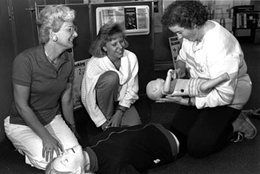Appeal launched to support people impacted by the earthquake in Myanmar
Read More

At the end of WWII, the Canadian Red Cross Society (CRCS) moved smoothly back into full-time public health work. Older initiatives like the outpost hospitals, First Aid and Home Nursing training, the Junior Red Cross, disaster relief, port services, and services to veterans in hospital had continued throughout the war, and carried on into the new post-war period. The Canadian Red Cross Corps assisted with local and provincial Red Cross work; the knitting and sewing of comforts and supplementary hospital supplies also carried into the post-war period (eventually renamed “Creations”), its products directed toward civilians in Canada, or international relief projects. The late 1940s saw the CRCS move into two areas which would help define its post-war work: Water Safety and a new peacetime Blood Transfusion service. Through a program of swimming lessons, lifesaving instruction, and advocacy, the CRCS attempted to make Canadians’ leisure time in and on the water less dangerous. Meanwhile, the wartime blood donation program for soldiers had proven so successful that it seemed natural to create a peacetime equivalent for the general population. Since health is a provincial responsibility, it took many years to come to agreements with each individual province about how the program would be structured, managed, and paid for; slowly but surely, however, under the steady hand of Dr. W. Stuart Stanbury, a Canada-wide blood system (with no cost to the recipient) came into existence. The availability of blood for medical use helped make available a whole range of new treatments in Canadian hospitals. Many provincial and local branches set up health equipment loan services in this period, providing crutches, wheelchairs, and the like on short term loan to Canadians convalescing at home.
The broad outlines of the CRC’s post-war work were established by the end of the 1940s, and continued in many ways unchanged through ensuring decades. There were, however, important developments along the way. The 1949 entry of Newfoundland into Confederation added another provincial division to the CRCS family. As government health care provisions extended their reach, outpost hospitals were gradually closed or were transferred to local communities (which had been the original goal). The interwar Visiting Housekeepers evolved into Homemakers helping the elderly and ill. The wartime Enquiry Bureau which attempted to trace missing troops transformed over time into a Tracing and Reunion service which helped re-establish contact with, first, displaced persons in Europe in the aftermath of the war, and, later, any family members in Canada or overseas with whom contact was lost as a result of war, natural disaster, or other upheaval. During the Korean War (1950-53), the CRCS sent a group of women volunteers – known as the Far East Welfare Team – to Japan to do welfare work with Canadian soldiers, and Canadian Red Cross Society personnel were also involved in monitoring the international situation in Korea itself. In 1952 the CRCS was honoured to host the 18th International Red Cross Conference in Toronto, welcoming 55 national societies and representatives of their governments, as well as members of the International Committee of the Red Cross and League of Red Cross Societies. By the late 1960s, the CRCS responded to the spirit of change sweeping the country by transforming the Junior Red Cross program into Red Cross Youth; in ensuing decades it would integrate young Canadians into the senior society more fully. The Corps disbanded in the early 1980s. Meanwhile, the CRCS played an active role in bringing Hungarian refugees to Canada in the mid-to-late 1950s, and sent financial aid and/or relief workers to victims of disaster and war in places like Yugoslavia, Guatemala, Algeria, Congo, Nigeria, and a host of others. Overall, during the post-war period the CRCS became more internationally-engaged than ever before, while maintaining and expanding its domestic public health and disaster relief work.
In 1965 the entire International Red Cross and Red Crescent movement embraced a declaration of seven Fundamental Principles which guide the humanitarian work of the organization and its members (such as the CRCS) around the world: humanity, impartiality, neutrality, independence, voluntary service, unity, and universality.
Source:
CRCS. Annual Reports. 1946-1989